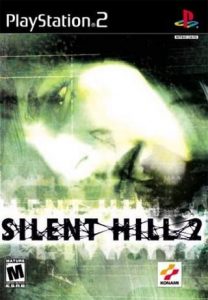
The following is part of Now Loading, a series that renders verdicts on whether or not your favorite video games deserve a place in the canon of works that have contributed to video-game storytelling in landmark ways. Read the series’ full mission statement here.
I Got a Letter…

Story and Characters: Welcome Back
The story of Silent Hill 2 is one steeped in depression, loneliness, and most importantly, guilt. It follows James Sunderland, a man drawn to the town after receiving a letter from his supposedly deceased wife, Mary. We open on James splashing water on his face in a derelict roadside rest stop. After a shot of James looking at his sullen reflection in the mirror, he takes a last look at his squalid surroundings and takes his first step on the journey that will comprise the rest of the game. He walks outside the pitiful, dilapidated rest stop and takes a moment to look out over the lake, but the reflection of the placid lake offers no more answers than the dirty bathroom mirror.
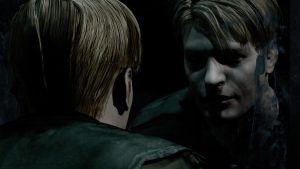
As James looks out across the lake onto the resort town of Silent Hill, his inner monologue informs the player why he has driven into this sullen place. He received a letter from his now dead wife, Mary, asking him to meet her in their “special place” in Silent Hill. He ponders over whether she means the lake or the hotel, before exasperatingly concluding that the whole of the town was their special place. The player realizes at this point that, although James Sunderland has a few ideas where to go, we’ll have to explore the foggy town of Silent Hill to find out whether or not James’ wife Mary is actually contacting him from beyond the grave and luring him to this place where they shared so many special memories.
In my restless dreams
James leaves the area overlooking the town so that he can enter the town proper, but before doing so he enters a cemetery on the outskirts of town and encounters a woman by the name of Angela Orosco. Although Angela is jittery and scares easily, she eventually warms up to James and, after he tells her he is trying to get into town, she lets him know that Silent Hill is a bad place, and that he would be better off just turning tail and going back the way he came. When James asks what Angela is doing so close to such a bad place, she says that she’s looking for her mother, and believes her to be somewhere in the town. James tells her that he’s also looking for someone, and in a moment of silent, tacit understanding, Angela tells him how to get into the town before issuing her final warning.
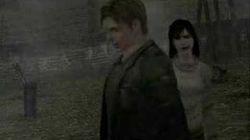
Not that he would listen
When James reaches the town proper, it is immediately clear that Silent Hill is not the same bustling, lovely resort town which he and Mary had visited. Instead, it is a disgusting place littered with garbage and broken down husks of houses, and what’s more, there are nightmarish monster creatures roaming the streets and plaguing James as he tries to find his way through the town. The streets are either barricaded or broken, and so it is impossible for him to press onwards towards one of the special places to which Mary may have been referring. His last option to press onward, it turns out, is to enter the Rosewater Apartment Complex, navigate his way through it, and come out the other side so that he can make his way through the town. Unfortunately for James, the old apartment complex houses more than just old memories and regrets.
As James makes his way through the complex, he meets a few people who will become important to his journey. His first encounter is with a hellish, pale humanoid creature with a metal pyramid object placed upon its head. Clothed in nothing but a butcher’s apron, James sees this monster of a creature force itself sexually onto a number of other monsters which James has encountered. Strangely, though, when James sees the monster for the first time, it doesn’t even try to attack him. This monster, this Pyramid Head, seems far more preoccupied with its deluded, horrific sex acts it happens to be committing at the time.
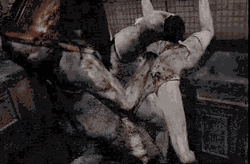
After escaping from Pyramid Head, James meets a young girl by the name of Laura who is inexplicably exploring this nightmarish Hellscape just as James is. And yet, unlike James, Laura seems to be unaffected by the horrifying visions and monsters which plague James’ journey. Laura is something of a brat, running around the abandoned alleyways of Silent Hill as if it’s all some twisted vacation she’s taking.
Lastly, James runs into a near obese man named Eddie Dombrowski as he openly vomits into one of the apartments’ toilets. Naturally, James asks if the man is alright, and urges him to leave this crazy apartment complex due to all the sexual assault monsters running rampant throughout the halls. Eddie shrugs off these warnings, seemingly oblivious to whatever the hell James is prattling on about, and after trying his best to help out this poor vomiting stranger, James takes his leave and makes his way to the exit.
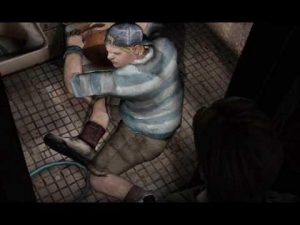
Before he finds it, however, he runs into Angela Orosco once more as she lies in front of a wall-sized mirror laid out before her. She is clearly in duress, and is holding a butcher’s knife near to her breast. Quickly realizing what Angela is contemplating, James attempts to coax the knife away from her, saying that it’s not right to think about suicide like she is. After saying something about trying to find her mother again, Angela reluctantly hands over the knife to James just before violently running out of the apartment complex promising that she will find her mother.
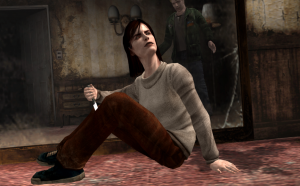
To me it always—
Finally, James makes it out of the apartment complex and is about to make his way towards Rosewater Park, but just before doing so he runs into the little girl, Laura, again just outside of the apartment complex. At this point, James has had multiple run-ins with terrifying monsters and a few strange people, so he questions just what the hell a little girl like Laura is doing in an awful place like Silent hill. Laura, ever the brat, tells him that the town is just fine, and that it’s just like him to say something so weird after all the horrible things he did to Mary. She continues, “You never even loved her anyway!” Then she runs off, leaving James baffled by her knowledge of his relationship with Mary, and befuddled by how terrifying Silent Hill has become.

After his encounter with Laura, James reaches Rosewater Park, hoping against hope that this is the special place which Mary had mentioned in her letter. As he explores the area, he comes across someone who looks exactly like Mary, and, with excited disbelief in his step, he rushes towards her, only to be met with a woman who looks identical to his late wife. She claims to be a woman named Maria, with absolutely no knowledge of James. He explains the strange situation, and she flirtily agrees to accompany him on his journey to find the so-called “real Mary.” James then thinks that, if Mary isn’t at Rosewater Park, she must be at the Lakeview Hotel, which is the only other specifically special place he can think of that she would call their “special place.”
At this point, all the main characters have been introduced to the story; the remainder of the game is an exploration of the derelict Silent Hill as James Sunderland attempts to solve the mystery of his wife’s ghostly correspondence with him. So far in the story, we have been introduced to James, Angela, Laura, Eddie, and Maria, and what follows after James and Maria’s encounter in Rosewater park is the gradual descent to insanity that each of these characters (with the notable exception of young Laura) endures as they spend more time in the town of Silent Hill.
Usually in a Now Loading article, I would draw a definite delineation between an analysis of the game’s story and its characters, but to fully appreciate the impact of Silent Hill 2’s story, it is important to fully understand our characters at this point in the story. We will return to the story in just a few paragraphs, but do yourself and me a favor by indulging in the following character study.
By the time the player reaches Rosewater Park, not much is really known about James Sunderland. James, much like Harry Mason before him, is meant to be a somewhat bland everyman character to which we can instantly relate. And through his simple dialogue and occasionally muted reactions to horrible things around him, we as players can successfully put ourselves in the shoes of our avatar. That being said, we are certainly given a number of clues both in text and subtext as to what kind of man James is. We know he has endured a great loss with the death of his wife; however, we also know through his coming to Silent Hill that he is a hopeful man, willing to put all logic to the side in the hopes that maybe, just maybe, his dead wife is still alive and residing in the resort town that the two of them loved so much. We are shown that there is something deeper to James right off the bat, and through his interactions the other characters—specifically Laura—we see that he is very different from the likes of Harry Mason.
James is a man of very little patience. Yes, he shows compassion for Angela and Eddie when he sees them in their respective predicaments, but his cadence and demeanor imply that there is an edge to him that wishes these people would just get on with it already. Nowhere is this more evident than in his interactions with Laura: he routinely chides and chastises her for being such a little brat, and for not recognizing the danger she is in simply by being in this wacked-out town. One could certainly make the claim that this is James expressing something like fatherly concern towards the girl, à la his series predecessor Harry Mason, but one could also make the argument that James is just fed up with this little brat, and wishes that she were out of his way for good. I wouldn’t call this malicious, by any means—just human. We’ve all had moments of duress when we’ve wanted to yell at a child or tell some moron to beat it, and not all of us can have the protagonistic patience of Harry Mason.
While we’re discussing frustrating children, let’s take a deeper look at Angela Orosco. Angela is the first person we meet in Silent Hill 2, and that is no coincidence. Angela’s dialogue often comes off more childish than Laura’s, as if she were actively attempting to sound like a child without an adult grasp on the horrors of the world around her. Unlike Laura, however, Angela has had an intensely real experience with the terrors of man, and it quickly becomes clear to the player that her childlike cadence and manner of speaking aren’t a developmental disorder or weird fluke of voice acting, but rather a deliberate choice on her part to make her seem more childlike and innocent than she is.
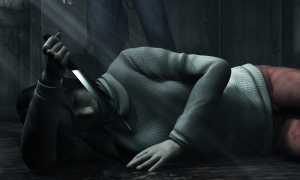
Angela Orosco is notable for many reasons, not least of which being that she is the first character James meets in the game and the only character whose fate James cannot know by the end of the game. The reason for that, perhaps, is that she is by far the most damaged, tragic character in not only Silent Hill 2, but also in the entire Silent Hill series.
During his travels through Silent Hill, James encounters Angela for the third time as she is trapped in a room covered with human flesh and adorned with little metallic holes, all of which have phallic, eel-shaped tentacles protruding from them. Though never explicitly stated in the text of the game, it is made clear through visuals and Angela’s dialogue that she was repeatedly molested by her father, and that her mother did nothing at all to stop his monstrous actions.
Because of Angela’s horrible trauma and the fact that no one, not even her mother, came to help her, she convinces herself that she is an ugly “thing” unworthy of love, and pushes anyone who even tries to help her as far away from her as possible. And yet, we come to learn that the town of Silent Hill is not needlessly cruel: it takes people as its victims only if, and because, they have a sin from which they cannot recover. Angela killed her father by burning her house down, and while I can’t think of a soul among you who would blame her for this, that’s not the point: Angela blames herself.
She blames herself for being assaulted, she blames herself for not asking for help, and she blames herself for her mother’s incompetence. She blames herself for her own pain.
We’ll discuss Angela and her tragedy further later on, but, in the meantime, just remember that her own perception has been so horribly warped that she first compartmentalized her abuse as guilt, and then carried that guilt well into adulthood, becoming incapable of realizing that the awful things that happened to her were not her fault.
Next, let’s take a look at Eddie Dombrowski, a man-child whose mental faculties are suspect at best. Eddie is a simple man, as shown by his childlike face and clothing, and this is only further emphasized by the backstory we are given that explains how he was ruthlessly bullied all throughout his childhood for being a big, dumb, fat guy. This bullying was so severe, in fact, that it persisted in one case after high school, with one of his bullies constantly following him to his job as a gas station attendant and performing both physical and mental harassment until Eddie finally snapped and shot him dead.
Eddie, much like Angela, is portrayed to us as a simple child who fell victim to his own terrible circumstances. And while a case could be made comparing the two characters, I will draw the line between them when it comes to how Eddie reacted to his abuse. Angela burned her house down and killed her father in the process, and yet through the repeated imagery of her holding a knife to her own chest, it is implied that she hoped to die in that fire as well. The fact that she didn’t only adds to the guilt she feels, and so every action she takes in Silent Hill 2 is in service of ending her own pain. Eddie, on the other hand, just wants others to suffer as much as he has.
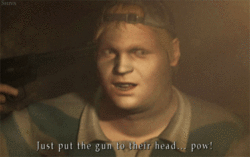
At a later point in the game, James encounters Eddie in a meat locker after he killed someone for “bullying him.” Whether that actually happened or the town was just playing tricks on his mind, Eddie made the deliberate choice to take the life of someone who he thought was doing wrong by him. And, as we know from his backstory, this is not the first time Eddie has taken revenge on someone who has “bullied” him. He shot the man in the meat locker just like he shot the kid from high school, and if James wasn’t able to see just how awful these people were to him, then Eddie was going to kill him, too.
James inevitably kills Eddie in a boss fight between them, and feels immediate regret and guilt for having done so. After the man-child dies of his multiple gunshot wounds, he collapses to the floor, and James laments the fact that he has killed another human being. He has, in his mind, taken the life of someone who truly did not deserve to die.
In my restless dreams
Next is Laura, the carefree child who is inexplicably frolicking through this nightmarish hellscape along with James. Laura, we eventually find out, was a patient at the same time James’ late wife Mary was, and grew very close to her, as if she were her own mother. Mary, in her last months, was not allowed to leave the hospital, and so having a sick child come in to visit her everyday was a boost to her spirits
because he wasn’t there
And as such, Laura became so close to Mary that it is clear Mary saw her as the daughter she would never be able to have. Mary relayed to Laura all the wonderful stories about James, and how she couldn’t wait to see him after all this terrible sickness was over and done with. Naturally, neither of them truly believed that Mary would get better, but Laura was young and innocent enough to hope that maybe, one day, this “James” who Mary kept talking about might walk through the door and pay them a visit. Too little, too late, I suppose.
what did he say
The most interesting thing about Laura, as I see it, is that she is essentially the normalcy test when it comes to the strange perception field that Silent Hill imposes on its victims’ minds. We’ll get more into that in the next section, but essentially, Silent Hill and its demonic denizens look different to everyone who enters the town. Basically, the town is a mirror that reflects your own personal demons, and so to James, Angela, and Eddie, everything and everyone they see during their time in Silent Hill looks completely different. However, to an innocent child like Laura, the town just looks like a deserted town. A little spooky, maybe, but it may as well be Ogunquit, Maine in the off-season. A few people here or there, but certainly no monsters. Laura, as a child, is the gauge for innocence and purity in this game.
And then we come to Maria
Mary
Maria
Mary
Mariaarymamamaria
Who is a strange doppelgänger of James’ wife, Mary. We’ll discuss monster designs
Later laaaaaaaaaaaater
So let’s talk instead about Mary, and how her crippling illness, followed by her untimely death, is really the entire crux of this game. When it comes to Mary’s personality, she is much like James in that we don’t know a whole lot about her. If James is the “husband” trope, than Mary is equally the “wife” trope. The huge difference, however, is that Mary’s illness is her sole defining feature in this game, and it is the entire reason for James’ trip into Silent Hill.
And with that, I suppose, we should look at the game’s ending.
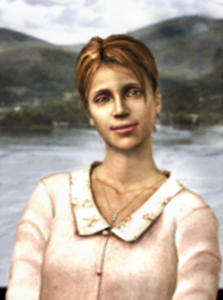
Silent Hill 2 has one of the most gut-wrenching endings to any game—nay, any story—and it has been unsuccessfully emulated time and time again by future Silent Hill developers and up-and-comers alike. You see, it turns out that the reason James was drawn back to Silent Hill was because his wife, Mary, had been cripplingly ill in the last few months of her life. We’re not talking about passing quietly into that good night kind of illness, either: we’re talking about one of those wasting diseases that makes your loved ones look at you as if you have become someone—no, something—else. James could not recognize the wastrel that his wife had become, and, in an act that could just as easily be seen as mercy or selfishness, James killed his dying wife.
This is what we were getting to, and those of you who are familiar with this game knew that this was coming. The ending of Silent Hill 2 reveals that James Sunderland killed his wife, Mary. And while there is an argument to be made about his mercy in killing her, the real, central theme of this game comes out in its deft exploration of guilt.
Guilt is a many-faceted thing, as we come to understand through playing Silent Hill 2. As an abuse victim, we can feel as if we are the ones to blame for the horrible experiences we have had. As the victim of bullying, we can feel as if we not only deserved the bullying for our outward appearance or personality, but we can also justify making life a living hell for others due to ill-perceived guilt we apply to their actions. We can feel guilty about any number of things, and what’s more, we can feel guilty about all of those things.
James Sunderland is a man who is wracked with guilt for many reasons. First and foremost, he feels guilt for the mercy-killing of his wife. I think it is safe to say that, if a relatively empathetic, sane person were to kill his or her significant other, he or she would feel a corresponding amount of guilt for taking a human life. Even if it were to put the person out of their misery, it is still taking someone’s life.
But that’s just it, Dear Reader. This kind of guilt is obvious. Of course you would feel guilty or ashamed for having killed someone in the last throes of their life. For a story’s theme to stop there would be pedestrian and, frankly, boring.
Silent Hill 2 never stops.
See, that’s the idea. Of course James feels guilt for having killed Mary, but the far deeper, far more frightening part of his guilt is that he was relieved to have killed her. She was a drain on his life and a tap on his own happiness, and even though she gave him permission to kill her, how in the hell does a normal person cope with feeling happy about killing someone who is a drain on your life?
Likewise, Angela surely feels guilt for having burned her house down with her father in it, but what about the next layer of guilt she feels for feeling happy about doing that? Or the fact that she is looking for her mother to kill her in order to put an end to the cycle of violence that spawned all this guilt she felt in the first place? Isn’t there a part of Eddie that feels guilty about the joy he takes in exacting revenge?
Even when something comes to a close, there is always something left, and Silent Hill 2 posits that this remainder is always guilt.
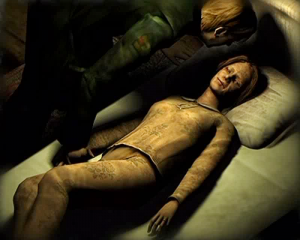
Guilt, in this survival-horror game’s case, is the true terror. And even in the “canonical” ending in which James leaves the town having come to terms with his own guilt, we are given a voiceover reading of Mary’s letter to him, in which she details how guilty she felt for her continued existence: how guilty she felt for being such a burden on this man she loved, and how guilty she felt that she couldn’t just put an end to it all herself and cut short his suffering.
Any run-of-the-mill story would end with the implication that the main character had eschewed his guilty conscience, but not this game. Silent Hill 2 ends with Mary, the victim of a mercy-killing, relaying that her time with James was the happiest time she’d ever had, and if it had been in her power to make him happy in some small way, she would have done it.
James, much like the player, will not—cannot—forget that guilt.
Gameplay, Music, and Visuals: Second Verse, Same as the First
You’ll find that with the Silent Hill sequels, the gameplay, music, and visuals are very much like the first game. The monsters are wonderfully designed to make you want to stay away from them; the puzzles are difficult, yet rewarding; and the town is just as foggy and unsettling as it was in the first game, despite the graphical upgrade on the PS2. The boys over at Team Silent knew a golden nugget when they panned one, and so they kept the fog as a staple of the town.
Actually, on the subject of knowing a golden nugget when you have one, Silent Hill 2 is perhaps the best example of a game sequel taking things from the first game and expanding on them in an interesting, meaningful way, rather than rehashing or corrupting what made the first game valuable. This sequel took what was most interesting about the first game—namely, the spooky town itself—and got rid of all the cult activity and demon-god summoning. Instead, the game was designed around how the town itself draws sinners and otherwise guilt-ridden individuals into it, and then warps their perception to show them a true nightmare that only their own mind is capable of conjuring.
For James Sunderland, that nightmare is the physical manifestation of all the different layers of guilt he feels for having killed his wife. Just as the monsters in the first game reflected Alessa’s tortured mind, the monsters in Silent Hill 2 are all carefully designed to represent James’ multiple frustrations and shames. Sexuality and sexual repression are intensely represented in this game, with all the monsters you encounter being some version of either a bound and angry man, or some hyper-sexualized, feminine monster.
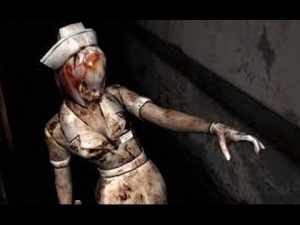
For example, the nurses that you encounter in your trip to the hospital are faceless, busty, and scantily clad, indicative of how James had a wandering eye during his hospital visits due to his wife being unable to engage in any sexual activity. There are also horrifying mannequin legs sewn on top of one another in a perverse reduction of femininity, which we see being sexually assaulted by Pyramid Head on a number of occasions.
Speaking of which, let’s discuss Pyramid Head in a non-hyped up way that depicts him not as a mascot of the franchise, but rather as an incredibly clever depiction of a man’s guilt and the self-imposed punishment that results from this guilt.
Pyramid Head is one of the greatest monster designs in any survival-horror game ever, and if this game were released in the late 1980’s, we would no doubt have a seemingly infinite amount slasher flicks starring ol’ Triangle Face running around, slashing people with his unwieldy butcher’s… sword. And while it may be true that Pyramid Head has been elevated to the status of series mascot, I don’t want to spend too much time on whether or not that is a positive thing for the Silent Hill games as a whole. I’ll simply say that, no, of course it’s not, and move swiftly on.
Based on the apparently terrifying executioners from the town’s past, Pyramid Head is the physical embodiment of the guilt James harbors about his wife and what he did to her. Pyramid Head is violent, hyper-sexual, and exists to berate and punish James for what he did to his wife and how he thought of her before her death. And yet, he does not exist solely to punish James for his wife, but rather for all harm he has ever inflicted on anyone else.
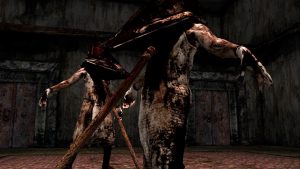
Before the final fight against Maria, James encounters not one, but two Pyramid Heads, even though he had only seen one up until this point in the game. The reason, it turns out, is because this encounter is after he has killed Eddie, and so we see that there is not one, but two monsters, representing the two people James has killed in his lifetime. What’s so terrifying about Pyramid Head, then, is not his crazy design, his creepy actions, or his ghoulish design, but what he represents.
You can’t kill Pyramid Head. You can only ever make him retreat, or stun him. Deep guilt doesn’t just go away.
It only stops for a while.
Impact on Gaming and Culture: In the Storytelling Canon, Not Just the Video Game Canon
Silent Hill 2 is a peerless masterpiece that I truly believe will never find its equal. It is a game that takes the best parts of literature, cinema, music, and most importantly, the interactive medium, and meshes them together to create an experience that delves into guilt and mental anguish, the likes of which very few stories ever dare do. It presents the player with a world that isn’t quite what it seems, and asks her to believe there is more to it than initially meets the eye. That’s not to say, of course, that it will ever provide the player with an answer, but that’s the point: some holes are never meant to be filled.
This is far and away the most critically acclaimed entry in the Silent Hill series, and it is evident that developers of later games tried to recapture the magic that this game offered, but to little avail. Lightning in a bottle can only come around once in a lifetime, and to try to recapture it would be like trying to birth a demon god from the eternal suffering of a little girl.
It’s just not feasible.
BONUS LEVEL: Angela Thanatos
Games like this are why I made this section.
James wends his way through the Lakeview Hotel so that he can get to Maria and put an end to all this. On his way, he has his final encounter with Angela, who is standing halfway up a staircase, looking at a fairly yonic painting. Huge flames are all around the staircase, and upon seeing Angela standing amidst the chaos, James reaches out to her.
“Mama!” Angela cries in her childish voice, walking towards James. “Mama, I was looking for you.”
She continues to move toward James, although now it is clear that her movements are less of someone happy to see an old friend, and more menacing. More threatening.
“Now you’re the only one left,” she says, hunching her shoulders and reaching towards James. “Maybe then… maybe then I can rest.”
The player gets the distinct feeling that the reason Angela has been looking for her mother has been to kill her, too, putting a stop to the cycle of violence that took from her that innocence that she has been feigning throughout the whole game. Maybe, she thinks, once her mother is dead, she can finally put her guilt to rest, and die along with it.
James backs away from her, but she persists.
“Mama, why are you running away?!” She grabs at James’ head, and then, as if suddenly blind, she feels around his face trying to piece together just what this person looks like, as if sight alone isn’t enough to determine that. “You’re not my Mama…” She realizes. James, perhaps recognizing that she is out of it, motions towards her, as if to extend some comfort.
“It’s you,” she says, backing away from James. “I’m sorry.” She shrinks back towards the flames licking at her heels as James comes closer to her.
“Angela, no,” he says, taking a few more measured steps in her direction. There is a long, quiet pause, and neither of them says anything. After this, Angela drops her childish voice and speaks like an adult, recognizing James as something other than her delusion.
“Thank you for saving me,” she says, crossing her arms defensively. “But, I wish you hadn’t. Even Mama said it… I deserved what happened.” She says this, and she believes it.
“No, Angela! That’s wrong!” James says, trying to convince her that whatever happened was by no means her fault.
Another pause as Angela shakes her head, raising her hands.
“No, don’t pity me. I’m not worth it.” She believes it.
Suddenly, her demeanor changes to something sultry, almost mocking. She looks directly into camera as if putting James on the witness stand, saying, “Or maybe you think you can save me? Will you love me? Take care of me? Heal all my pain?” Her sarcasm betrays the awful truth that she has fallen for these lines before. Maybe, you think, she will again.
“That’s what I thought.”
There’s yet another pause, although this time James bows his head as if he knows there is nothing he can do to help this woman. The damage has been done, and no matter what he says or does, saving her is beyond his power. Then, Angela breaks the silence.
“James, give me back that knife.” The knife from the apartment complex. The one that James was sure, at the time, she was going to use to kill herself—but who knows what it was really for, then. All that matters is that now, James thinks, she wants it for herself.
“No. I…I won’t,” he says, timidly.
“Saving it for yourself?” She replies, pointedly.
“Me?” Starts James. “No..I’d never kill myself…” No, he’d never kill himself.
Having run this conversation to its natural conclusion, Angela turns around and slowly makes the long walk up the burning staircase. She takes a few slow steps, when James makes one final effort to reach out to her.
“It’s hot as hell in here,” he says, almost jovially referring to the hellfire currently flanking them both. Angela turns her head to face James for the last time, and, with something like shock in her voice, she asks, “You see it, too?”
Another pause.
“For me,” she says, “It’s always like this.”
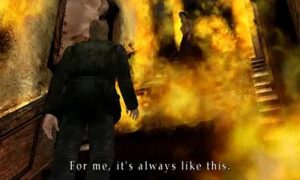
In one fell swoop, this final interaction with Angela shows us that it hasn’t only been James Sunderland running through Silent Hill and experiencing his own hell. Eddie, Maria, and, perhaps most tragically, Angela, have all been dealing with their own personal hells as they wander the foggy streets of this New England town. This one line puts the rest of the game into perspective, making not only James but also the player consider what the other characters may have been seeing when they interacted with James, and whether what the player was seeing was the same as what James was seeing.
Perception, like guilt, is layered and deceptive. It can trick us into seeing things that aren’t there, and, more terrifyingly, it alludes to the idea that what we see is not what others see, meaning that, even in our visual perception of the world… we may be alone. Even when we think the guilt is gone.
It just keeps coming back.
